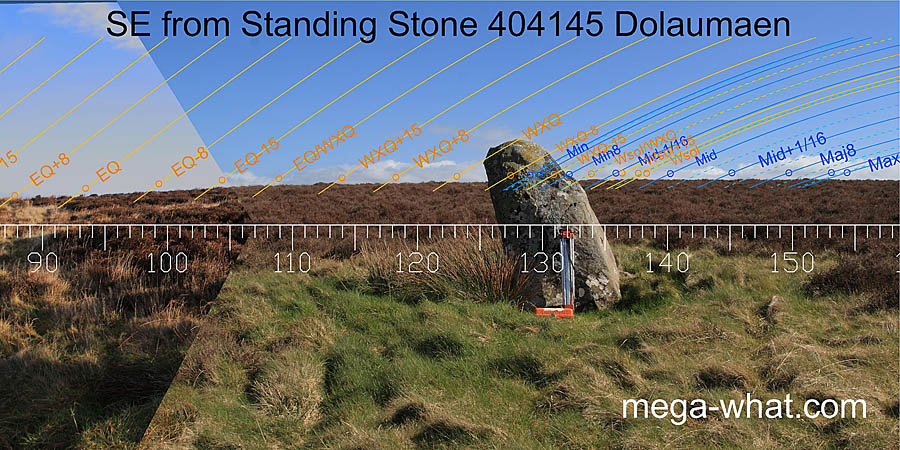 Dolaumaen Standing Stone is on the northern slopes of the eastern ridge of Foel Drych, between Crymych and Mynachlog Ddu.
It has been set, within fairly close limits, so as to be on the horizon when viewed from
Waun Lwyd Stone Pair, about 750m to the north-west as the crow flies. Its long axis is perpendicular to the sightline and it is about 2m tall.
Dolaumaen Standing Stone is on the northern slopes of the eastern ridge of Foel Drych, between Crymych and Mynachlog Ddu.
It has been set, within fairly close limits, so as to be on the horizon when viewed from
Waun Lwyd Stone Pair, about 750m to the north-west as the crow flies. Its long axis is perpendicular to the sightline and it is about 2m tall.
South is on a slope, to the right of an intersect [Pic].
North is in a dip, just to the right of an intersect [Pic].
The south-easterly view from this location was clearly not a siting consideration. Not for any utility of the ridge itself nor for a view over it to further horizons beyond.
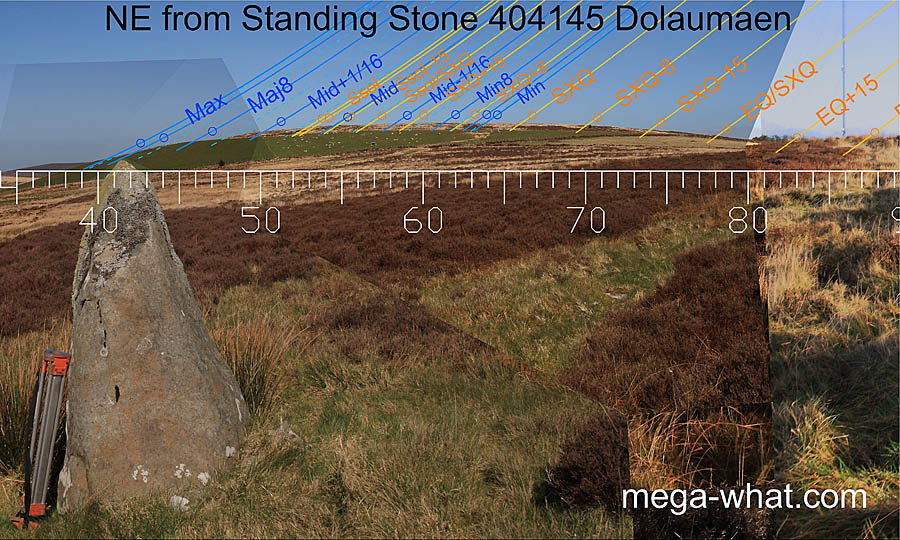 The stone axis indicates, to the north-east, the direction of major standstillLunistice positions vary cyclically over an 18.6 year period but are fairly static for more than a year at either end of the range
moonrise at the intersection of local and more distant horizons.
The minor end of the lunisticeLunistices are the most northerly and southerly moons of the month. The lunar equivalent of solstices - more.
range is at the top of the rounded ridge-end and the basal notch on the other side is a half-month from the equinox.
The stone axis indicates, to the north-east, the direction of major standstillLunistice positions vary cyclically over an 18.6 year period but are fairly static for more than a year at either end of the range
moonrise at the intersection of local and more distant horizons.
The minor end of the lunisticeLunistices are the most northerly and southerly moons of the month. The lunar equivalent of solstices - more.
range is at the top of the rounded ridge-end and the basal notch on the other side is a half-month from the equinox.
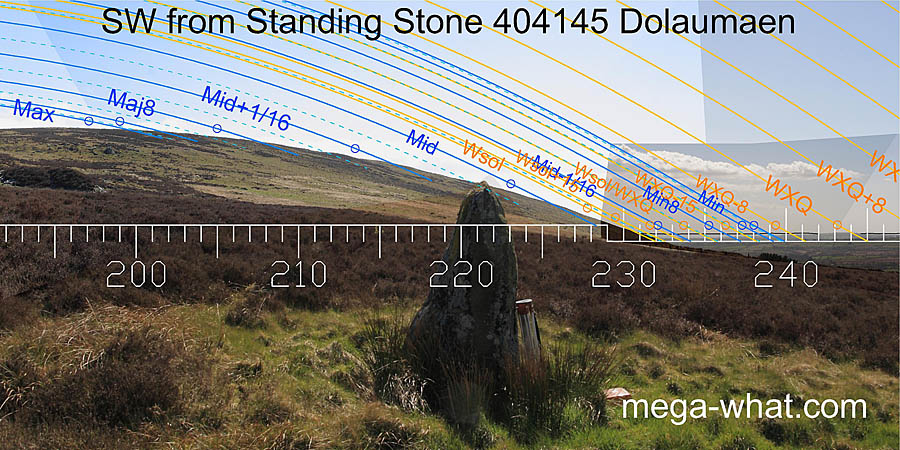 The south-west has winter solstice sunset at the intersect of near and far horizons.
The north facing slope of Foel Drych stretches out the major half of the lunisticeLunistices are the most northerly and southerly moons of the month. The lunar equivalent of solstices - more.
range over extra azimuth with moonsets around the major standstillLunistice positions vary cyclically over an 18.6 year period but are fairly static for more than a year at either end of the range
occuring over the hilltop.
The minor end of the cycle is on distant and fairly featureless horizons prone to being lost in haze that are over a dip in the nearer ground.
The south-west has winter solstice sunset at the intersect of near and far horizons.
The north facing slope of Foel Drych stretches out the major half of the lunisticeLunistices are the most northerly and southerly moons of the month. The lunar equivalent of solstices - more.
range over extra azimuth with moonsets around the major standstillLunistice positions vary cyclically over an 18.6 year period but are fairly static for more than a year at either end of the range
occuring over the hilltop.
The minor end of the cycle is on distant and fairly featureless horizons prone to being lost in haze that are over a dip in the nearer ground.
Winter cross-quarters are on a hill that rises above the distant horizon.
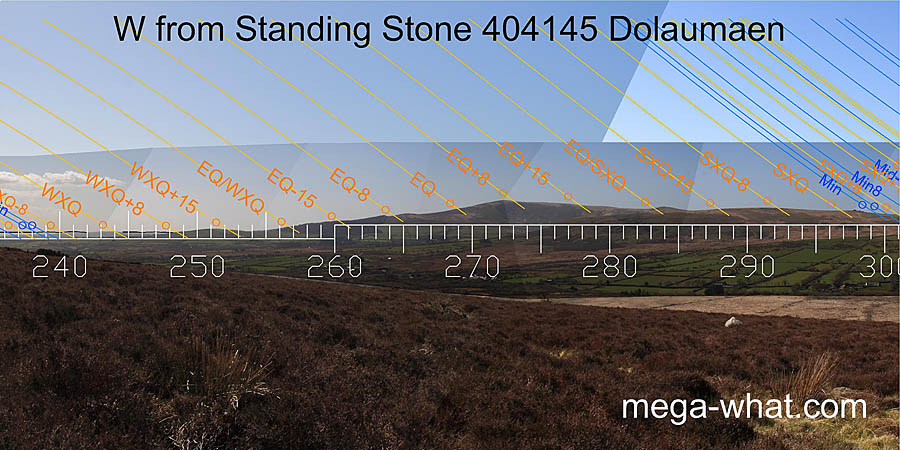 The intersect of far horizon and Preseli mountains is a quarter-month from winter cross-quarter and the first hilltop is a half-month.
A slight break in the ridge marks the equinox. Its quarter month brackets are at a lower break and Foelcwmcerwyn's top. The half-months are over slight rises to either side.
The next rise is half-way to the cross-quarter.
The intersect of far horizon and Preseli mountains is a quarter-month from winter cross-quarter and the first hilltop is a half-month.
A slight break in the ridge marks the equinox. Its quarter month brackets are at a lower break and Foelcwmcerwyn's top. The half-months are over slight rises to either side.
The next rise is half-way to the cross-quarter.
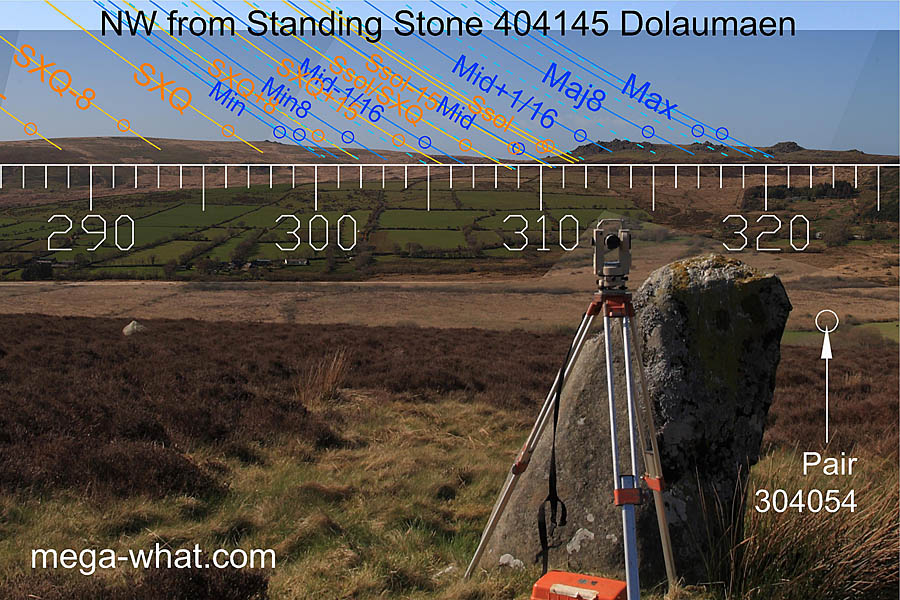 Summer cross-quarters are at the end of the ridge and lunar minor standstillLunistice positions vary cyclically over an 18.6 year period but are fairly static for more than a year at either end of the range
is at the start of the following slope.
Lunar midpoint and solstitial half-month bracket are in the dip at the foot of the slope.
Summer solstice itself is on the following upslope, just at the foot of the first rocks of Carn Menyn and the major end of the lunisticeLunistices are the most northerly and southerly moons of the month. The lunar equivalent of solstices - more.
range spreads usefully over those rock outcrops.
Summer cross-quarters are at the end of the ridge and lunar minor standstillLunistice positions vary cyclically over an 18.6 year period but are fairly static for more than a year at either end of the range
is at the start of the following slope.
Lunar midpoint and solstitial half-month bracket are in the dip at the foot of the slope.
Summer solstice itself is on the following upslope, just at the foot of the first rocks of Carn Menyn and the major end of the lunisticeLunistices are the most northerly and southerly moons of the month. The lunar equivalent of solstices - more.
range spreads usefully over those rock outcrops.
Curiously, a cruciform earthwork (Pillow Mound 308721) is less than 100m further up the slope beyond the stone. It may be seen clearly on Google Earth.
References
- National Monuments Record of Wales: Coflein database - site details.

